Will Gresson – 22 December, 2015
When walking through the dense structural features of Denny's work, it's difficult not to draw links with 'Secret Power', the Venice exhibition that served as the stepping stone to the artist's first major showing here in the UK. This is perhaps most noticeable in 'Products for Emergent Organisations', where vitrines made from server racks are again central to the arrangement of the installation.
London
Simon Denny
Products for Organising
25 November 2015 - 14 February 2016
Simon Denny’s new exhibition of work, Products for Organising, is a clear development from his highly successful appearance representing New Zealand at the 56th Venice Biennale earlier this year. Installed in the difficult space of the Serpentine Sackler Gallery in Hyde Park, London, the work is divided into two parts entitled Products for Emergent Organisations and Products for Formalised Organisations. Through these two different but interconnected sections, Denny articulates and explores a line of inquiry between hacker culture on the one hand, and a triumvirate consisting of the GCHQ, Zappos and Apple on the other.
When walking through the dense structural features of Denny’s work, it’s difficult not to draw links with Secret Power, the Venice exhibition that served as the stepping stone to the artist’s first major showing here in the UK. This is perhaps most noticeable in Products for Emergent Organisations, where vitrines made from server racks are again central to the arrangement of the installation. As in Venice, the vitrines here contain a collection of items both real and reimagined that pertain to the emergence of underground hacker culture, predominantly in the USA, during the latter half of the 20th century. As in Venice, graphics adorn the glass panels, explaining through a kind of scribbled mind-map some of the interconnected elements of each exhibit.
Among the objects is the ‘blue box,’ a tool used to hack the phone operating mechanism in the public pay phone system. The box generated the same tones used by a telephone operator’s dialling console to switch long-distance calls, which allowed users to route their own calls by imitating the in-band signalling mechanism. Early enthusiasts of the blue box included Steve Wozniak and Steve Jobs, future founders of Apple, and Denny has packaged the phone here to resemble an apple product, helping to frame the connection between both sections of the exhibition.
The vitrines were developed by Denny alongside artist/researcher Matt Goerzen and artist/brand consultant Emily Segal. They gather together various archival materials and present different narrative strands, giving a multi-faceted picture of the way that hacking developed from a series of connected communities. A selection of them are installed along a scaffolding, which crucially creates a moment where the viewer must stop and retrace their steps. Frequently, shows at the Sackler Gallery leave me feeling like I am trapped in some sort of loop, with few clear boundaries. It’s a boring trap that artists exhibiting in the space seem to commonly fall prey to, and Denny’s creation of a separate raised space helps demarcate the two parts of the exhibition somewhat.
At the far end of the space, the boundary is less clear however, and as you walk past another collection of vitrines, you find yourself staring at a series of large scale sculptural models, glossy and new, oozing corporate jargon and buzzwords. These are representations of the inner working of Zappos, Apple and the Government Communications Headquarters (GCHQ), the British equivalent to the GCSB in New Zealand. Some address concepts like Halocracy and Agile (management structures that eschew a traditional top-down hierarchy for a more fragmented or team based approach), others the geography of the companies (such as a model of “The Doughnut,” the headquarters of the GCHQ, designed by Chris Johnson for the firm Gensler).
By juxtaposing a branch of the governmental surveillance network with massive private companies, Denny is taking seemingly disparate - but in actual fact, highly inter-related - organisational bodies and drawing attention to their sinuous connectivity. It’s tactics like this that allow Denny to deal with such complicated or potentially loaded issues without necessarily making overt commentaries on them directly. In Venice, Secret Power dealt with the timely issue of government surveillance, placed in a firmly New Zealand context by discussing the country’s own role in spying as part of larger international networks like Five Eyes. This examination, done in a fairly clinical fashion all the while still being mindful of the setting of Venice itself, was a delicate juggling act of factors that Denny executed masterfully.
Here in London, the stakes are different, and the resulting works retain his almost trademark nonchalance but without necessarily recreating the quiet underlying tension of Secret Power. It is also difficult to shake the feeling that I’ve seen much of this work before. While in Venice the vitrines felt idiosyncratic and clever, here they seem familiar and heavy handed given the even more overtly ‘tech’ focus of his exploration of hacker culture. The museum aesthetic which fit so well into the Biblioteca Nazionale Marciana here is less seamless; a mock-up of a museum installed in an art gallery. Similarly the larger sculptural pieces that comprise Products for Formalised Organisations almost feel like Denny’s attempt to design imagery by working along the same lines as David Darchicourt, his muse of sorts for parts of the Secret Power exhibition.
There is no denying Denny’s technical or (forgive the pun) organisational flair. The Serpentine Sackler Gallery contains familiar hallmarks in terms of both tone and form, while still managing to respond to the setting and develop some of those interests further. The fact that my lasting impression of the exhibition is a sense that he did much of this work better at Venice may simply be a testament to the success of that show rather than an obvious shortcoming in this new body of work. What Denny does next in some ways feels like the crucial question here. Having explored some of these issues multiple times in previous exhibitions and also revisited formal approaches like the vitrines, it would be interesting to see his next projects demonstrate a greater movement away from both Secret Power and Products for Organising into new territories.
Will Gresson
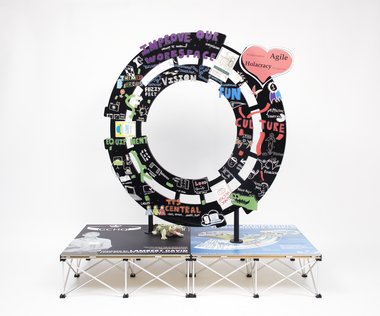
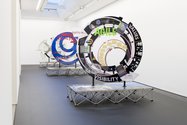
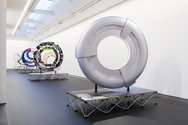
![SimonDenny, Modded Server Rack Display with Hack Change, 2015, detail [Narrative by Matt Goerzen, suggested product title by Emily Segal], mixed media, 100 x 745 x 100 cm. Photo by Nick Ash. courtesy of Galerie Buchholz Berlin/ Cologne](/media/thumbs/uploads/2015_12/sd_productsfororganising_1841_jpg_380x125_q85.jpg)

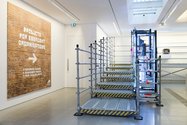
 Advertising in this column
Advertising in this column Two Rooms presents a program of residencies and projects
Two Rooms presents a program of residencies and projects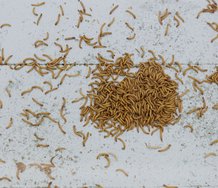

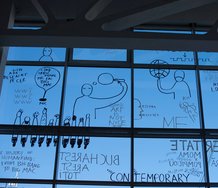
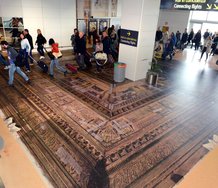
This Discussion has 0 comments.
Comment
Participate
Register to Participate.
Sign in
Sign in to an existing account.